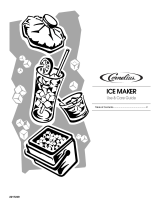
4
Important Safety Information
General Safety
Warning: Risk of child entrapment. Before you throw away any old appliance, remove the door(s)
so that children cannot be trapped inside.
!
!
• To prevent injuries, use at least two people to move and install the ice maker.
• This appliance is not intended for use by persons, including children, with reduced physical, sensory or
mental capabilies, unless they have been given supervision or instrucon concerning the use of the
appliance by the person(s) responsible for their safety.
• Install the ice maker in a well-venlated area where the ambient temperature is above 50°F and below
100°F.
• This series is designed to be installed indoors, except for models AIMG151PSSORH and AIMG151PSSOLH,
which can be installed indoors or outdoors. In all cases, the ice maker should be protected from rain, sleet,
snow, and / or moisture.
• This unit is not intended to be used by children.
• Children should be supervised to ensure that they do not play with this product.
• Never allow children to crawl inside the ice maker. If you are disposing of the unit, remove the door.
• Do not use this appliance near ammable gas or combusbles such as gasoline, benzene, or thinner.
• Do not store explosive substances such as aerosol cans with a ammable propellant in this appliance.
• Do not place the unit near heat sources such as ovens, grills, or direct sunlight.
• Only use in an upright posion on a at, level surface and provide proper venlaon.
• Do not pinch or kink the water or power supply lines between the unit and cabinet.
• Do not leave any cleaning soluons in the unit.
• Do not use solvent-based cleaning agents or abrasive soluons to clean the unit as they may damage the
interior and exterior.
• Do not place any other appliances on top of the unit.
• Do not turn the unit upside down, on its side, or at an angle o level.
• Do not move the unit without emptying the contents and securing the door in a closed posion.
• This appliance is meant for use in the household or similar sengs.
• Keep all venlaon openings clear of obstrucon.
• Do not damage the refrigerant circuit.
• If the supply cord is damaged, it must be replaced by the manufacturer, its service agent, or a similarly
qualied individual.
• Check for leaks aer installaon.
• Discard the rst batch of ice cubes produced by the ice maker.
• Never turn the water supply tap o while the ice maker is running.
• Do not pinch or kink the water supply lines and pipes.




















